Object-Oriented Programming and Java Part I: Introduction
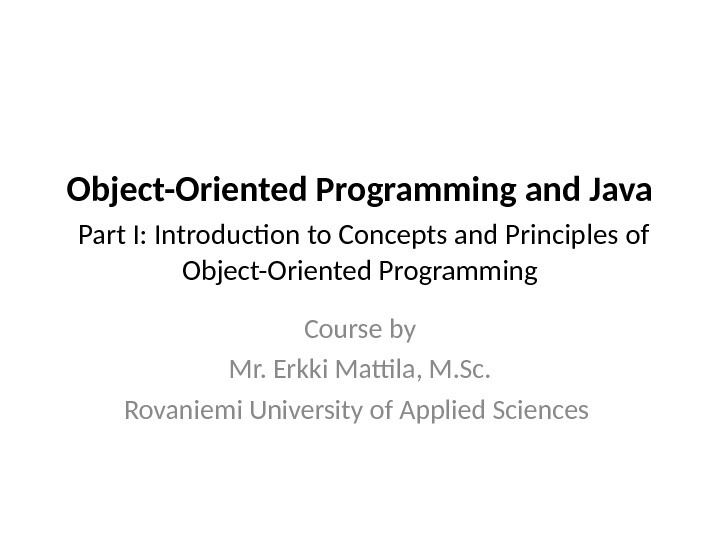

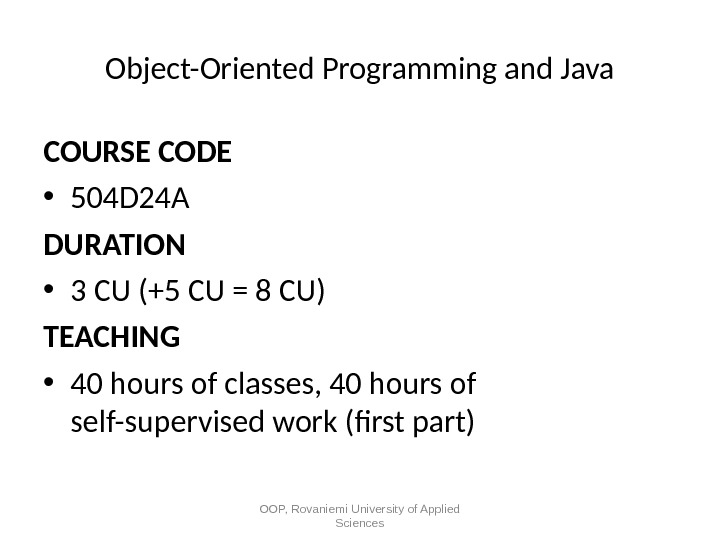
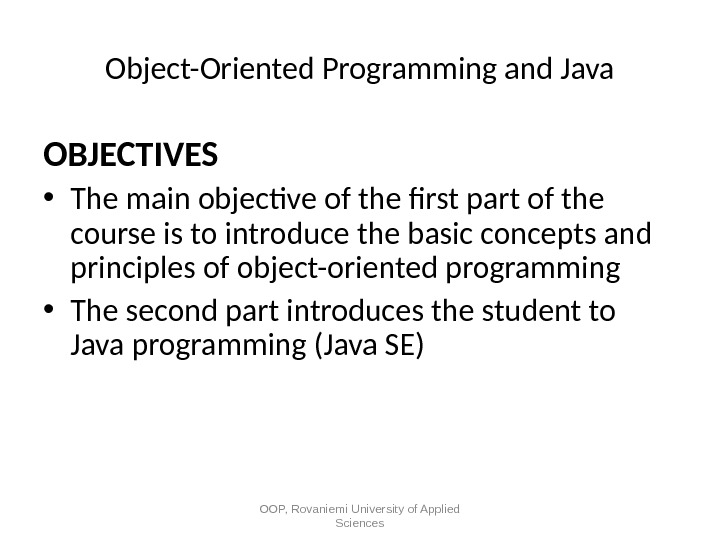
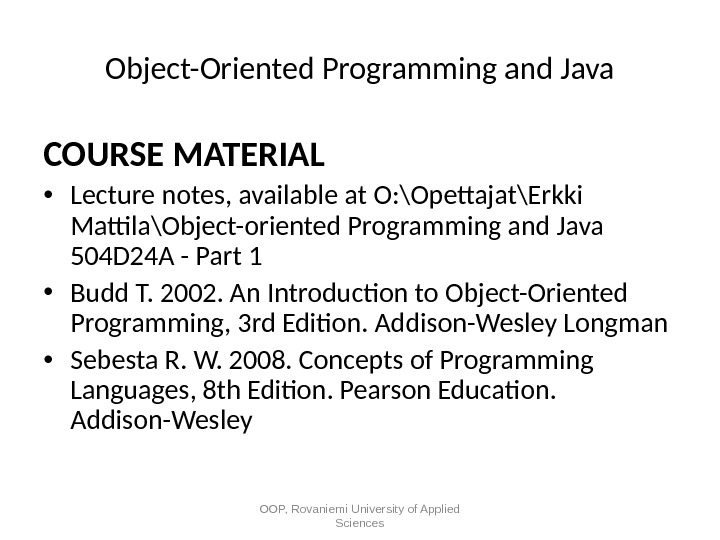
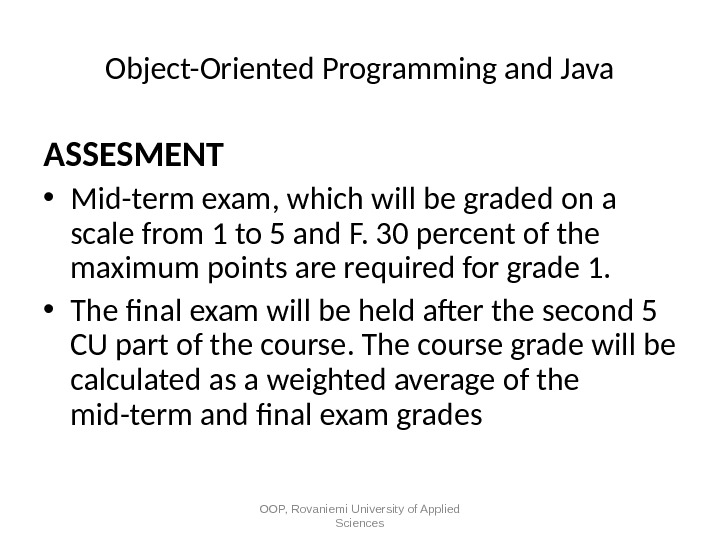
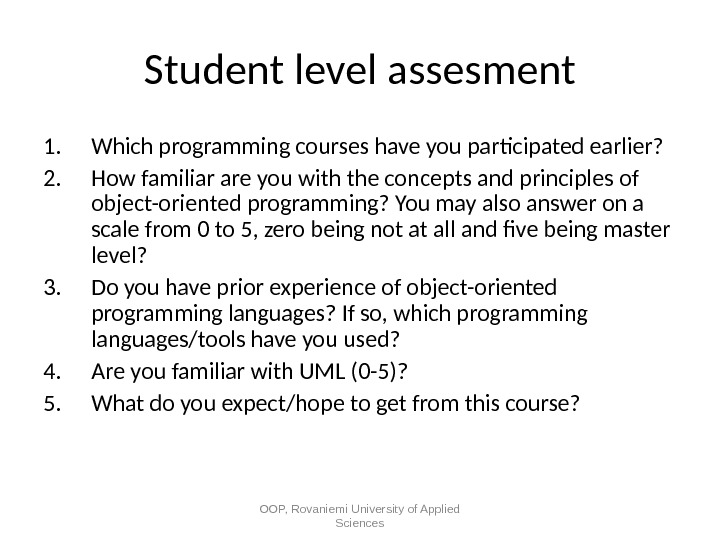

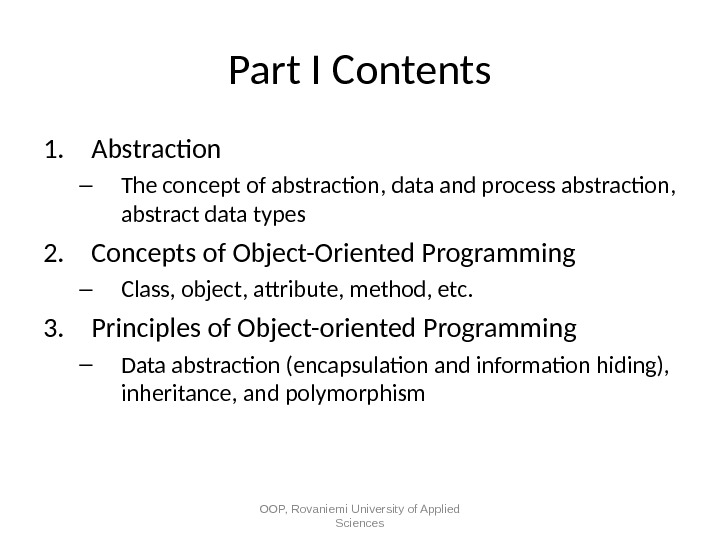

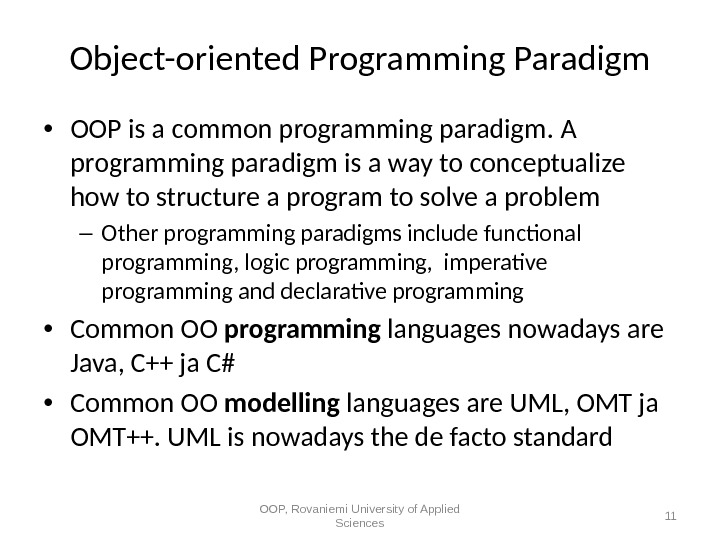
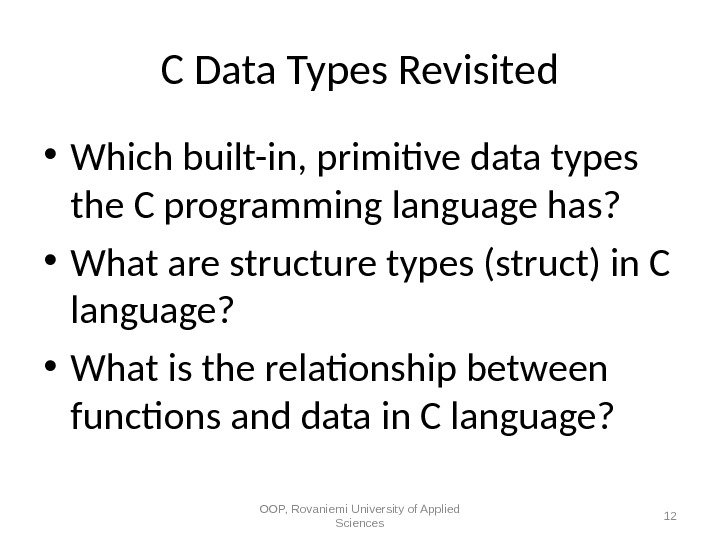
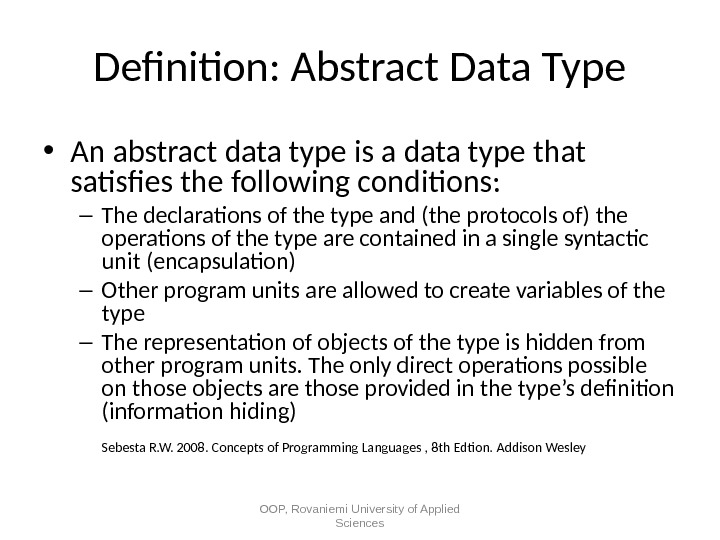
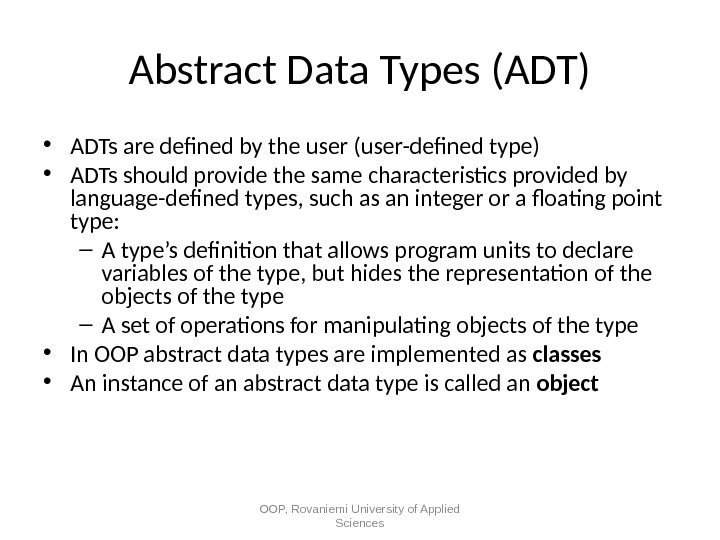

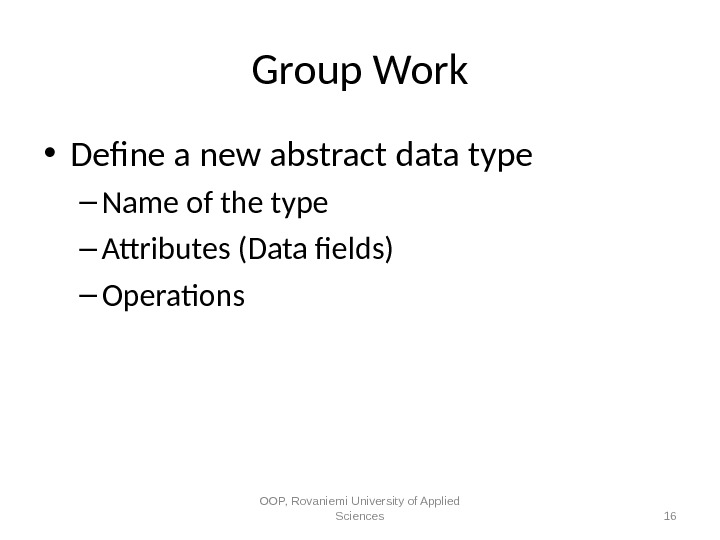
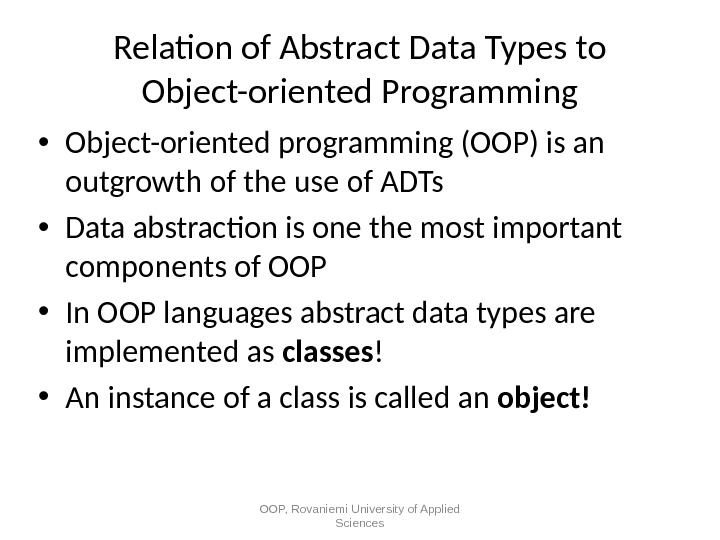

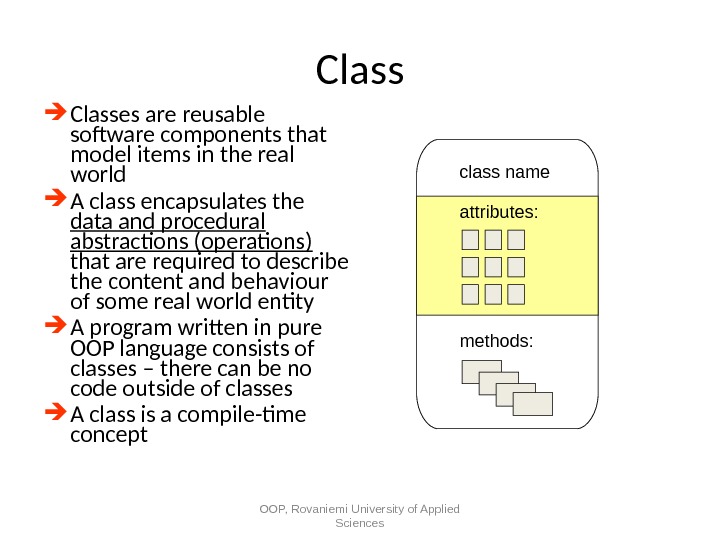

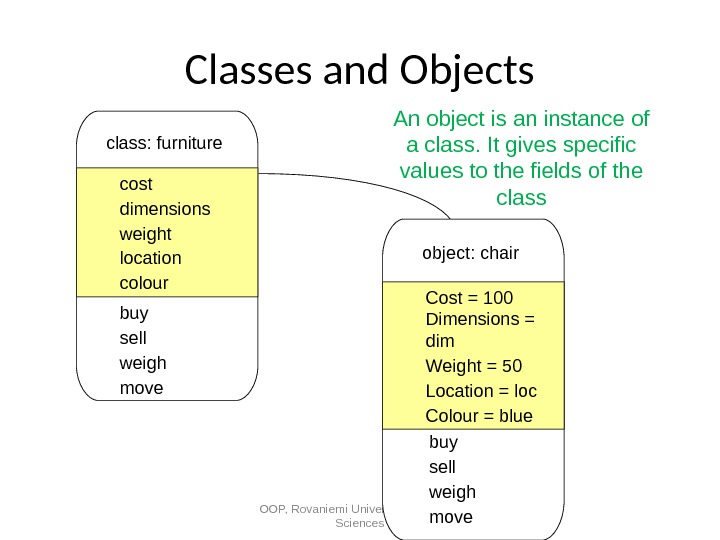
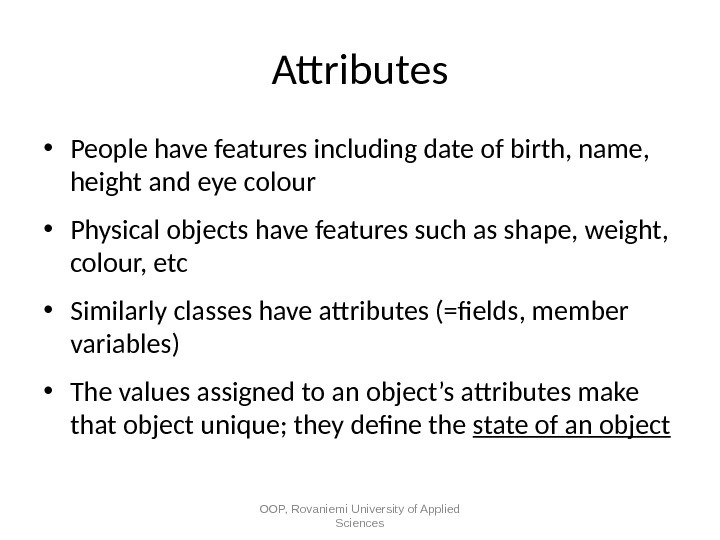
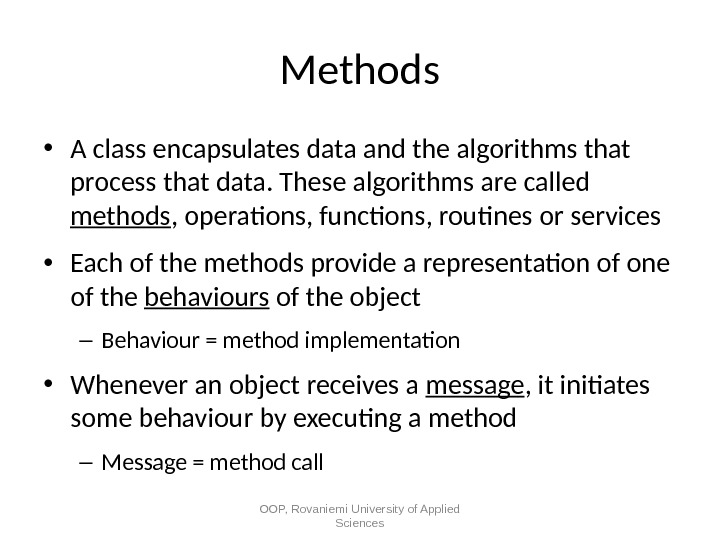
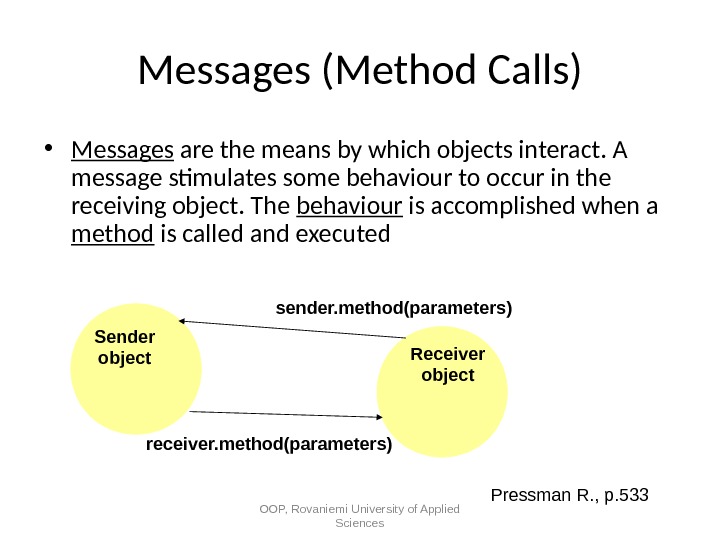
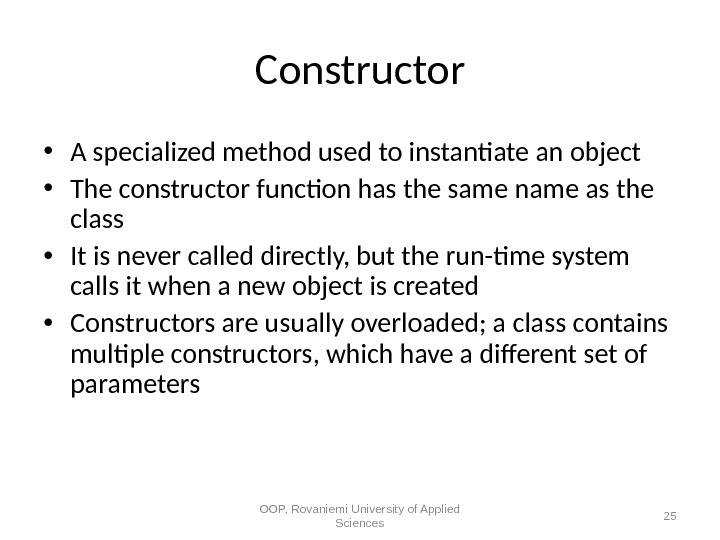
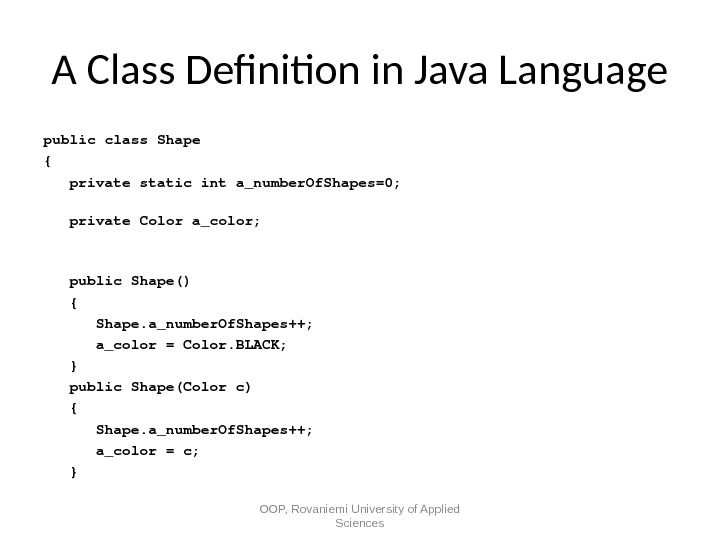
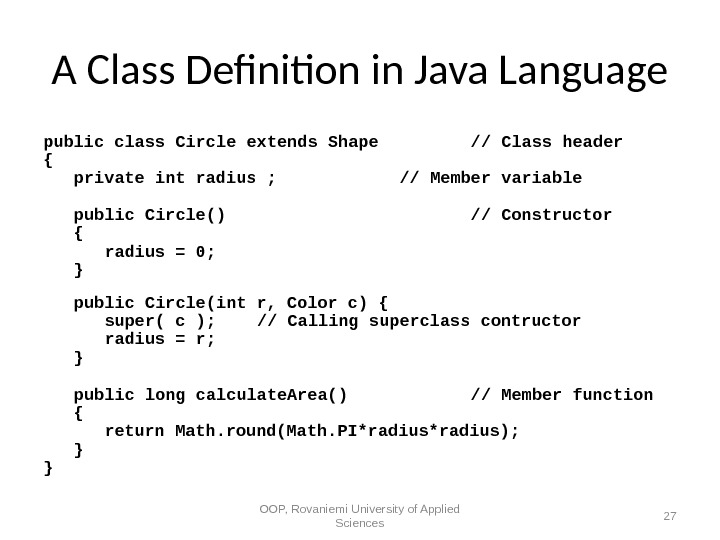

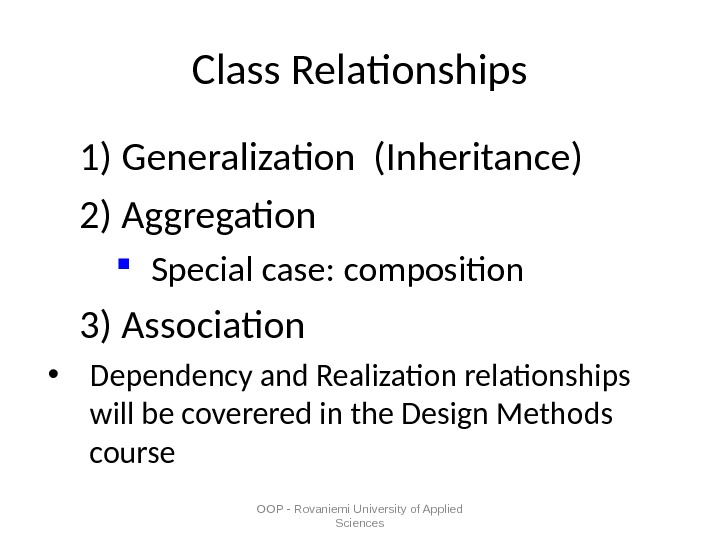
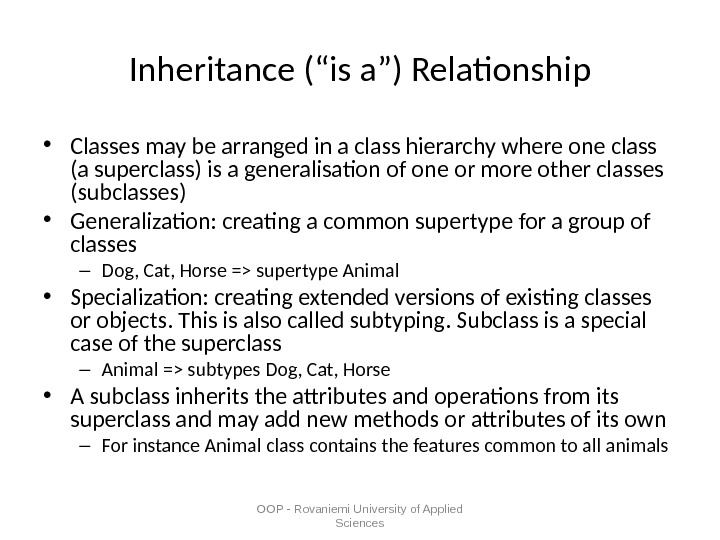

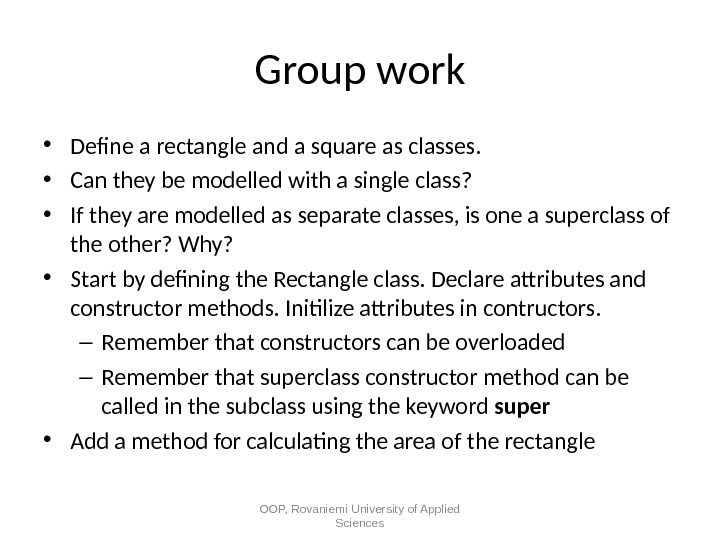
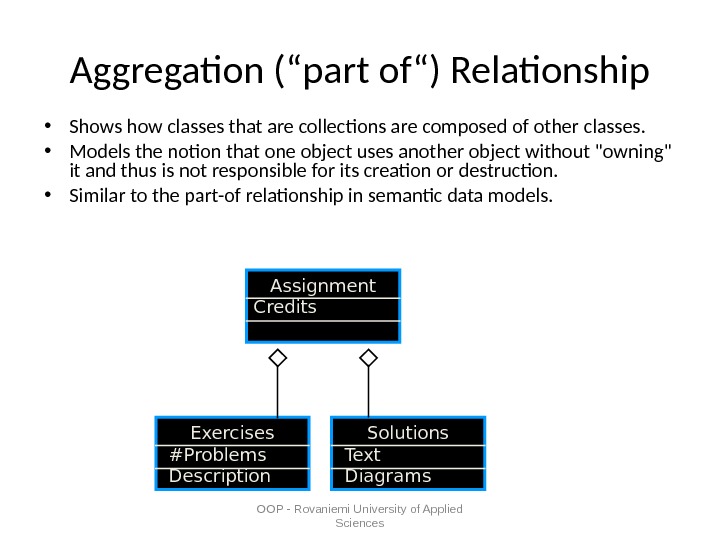

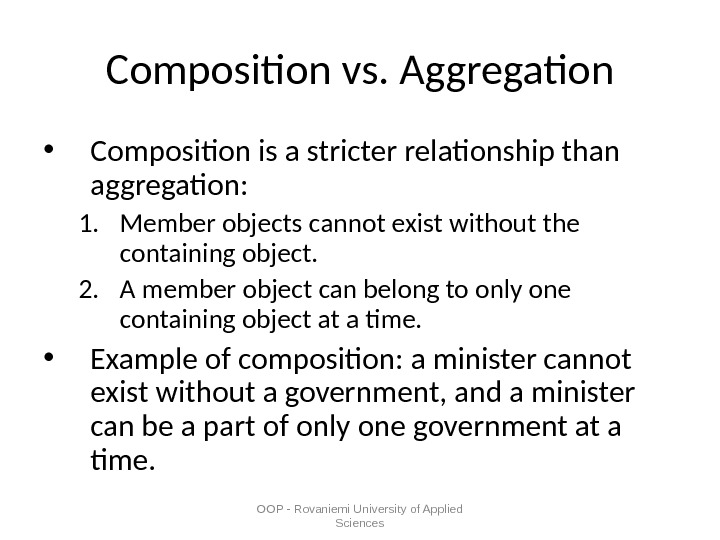
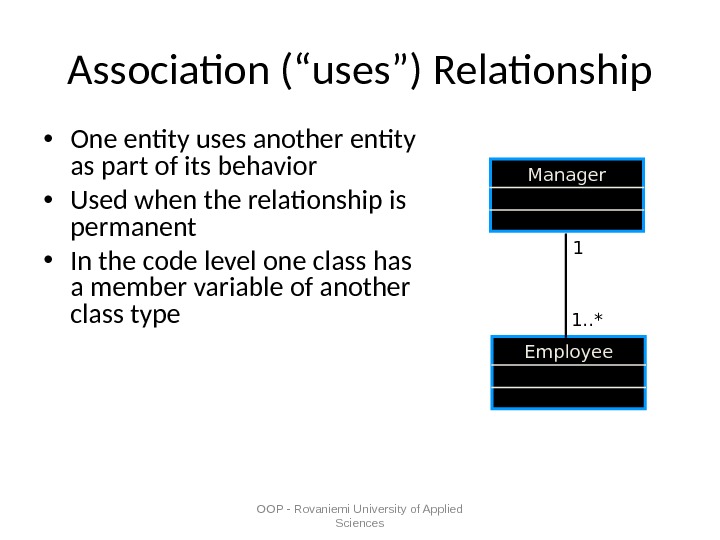
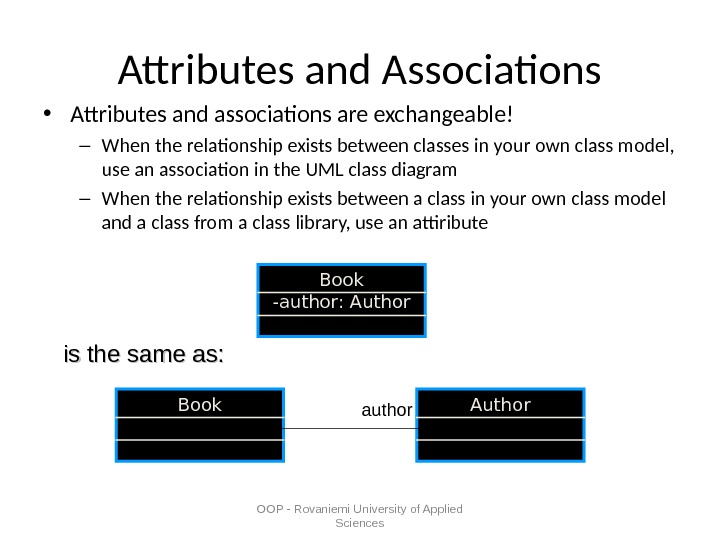
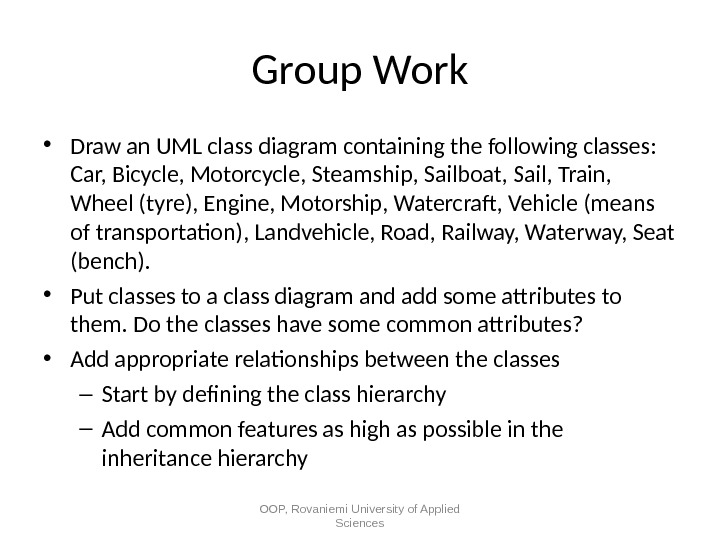
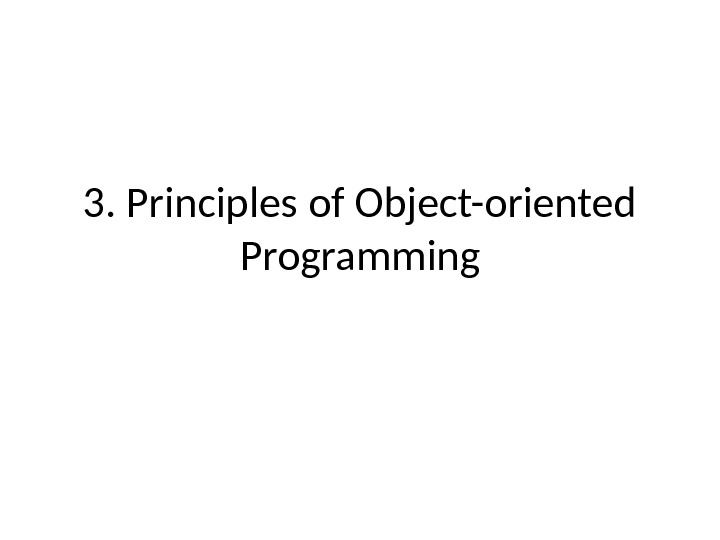

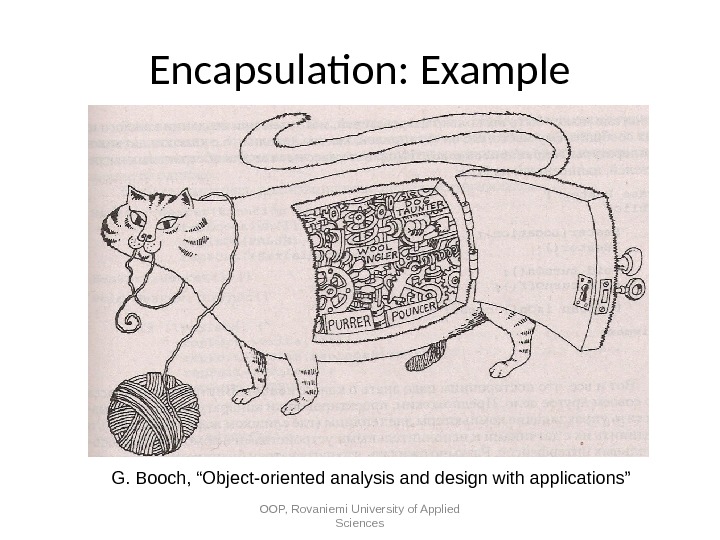
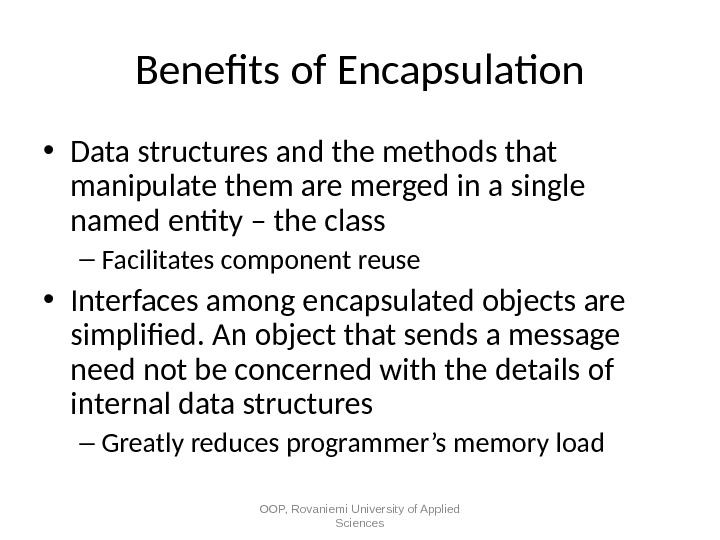

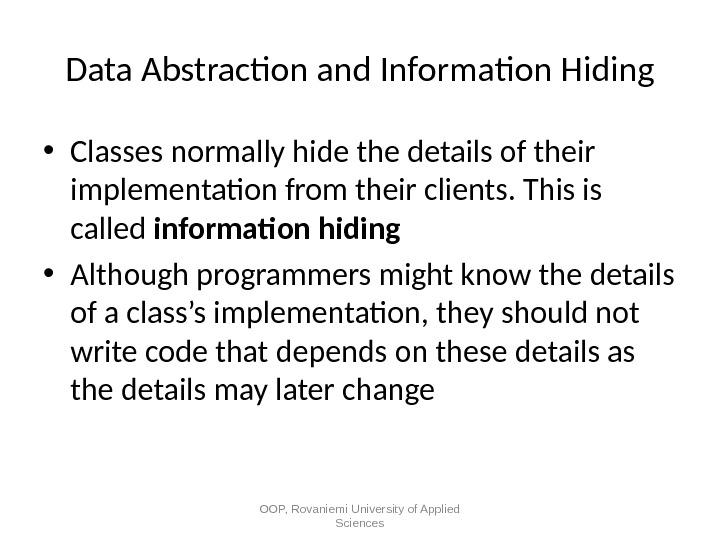
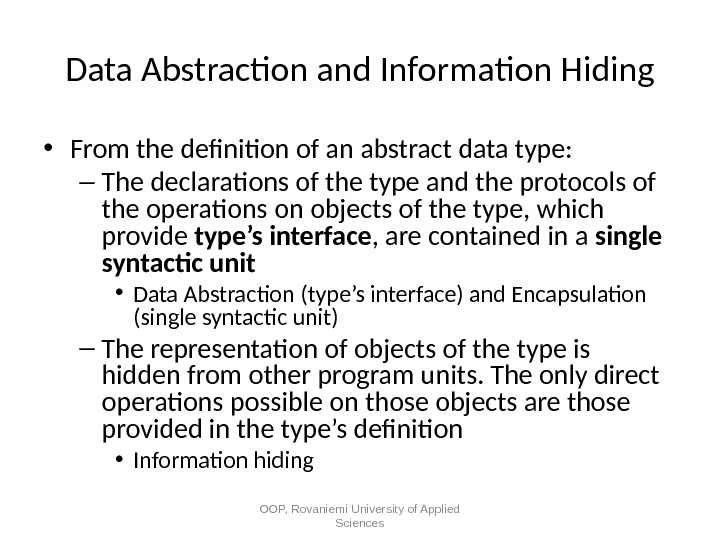
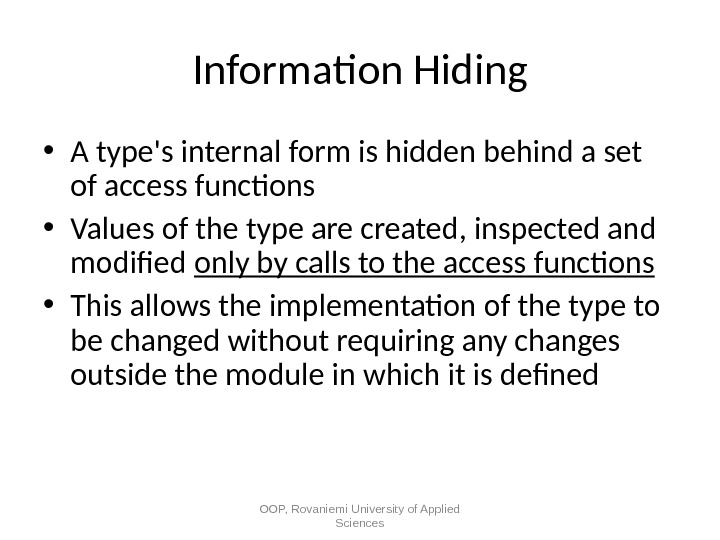

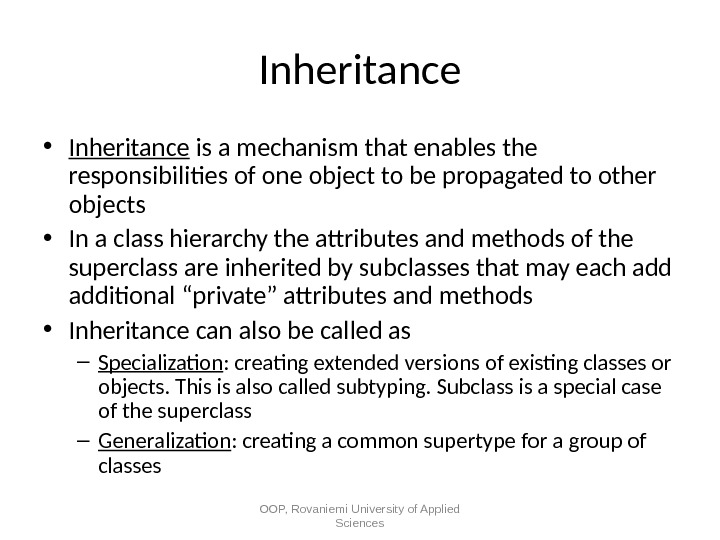
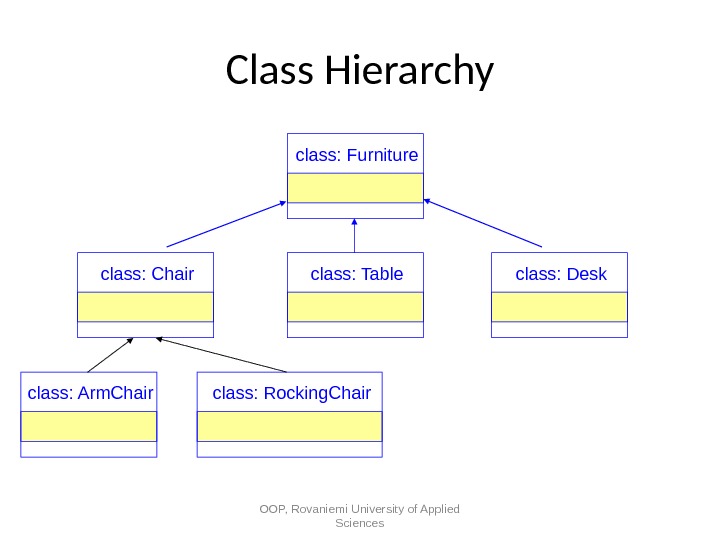
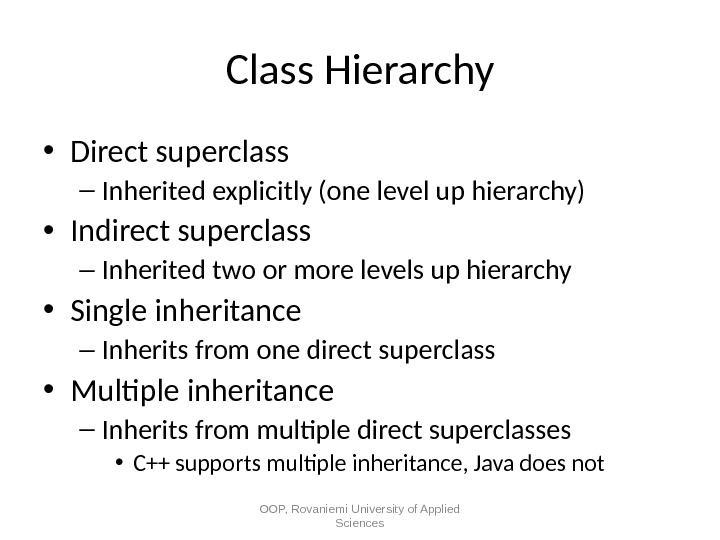
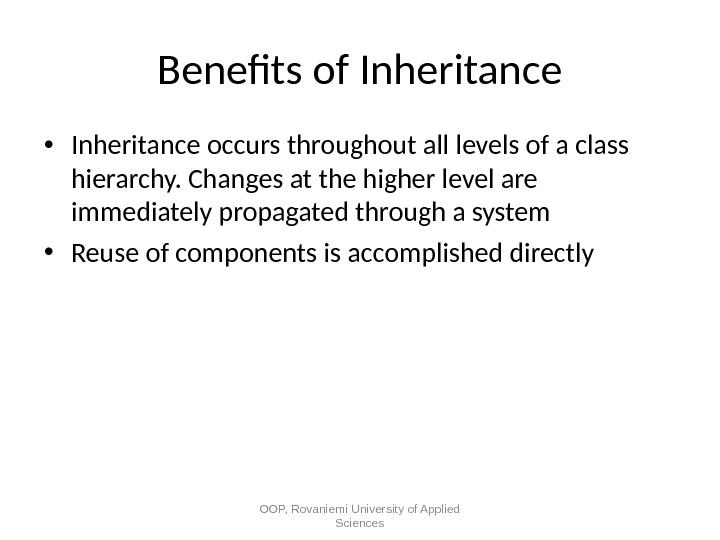
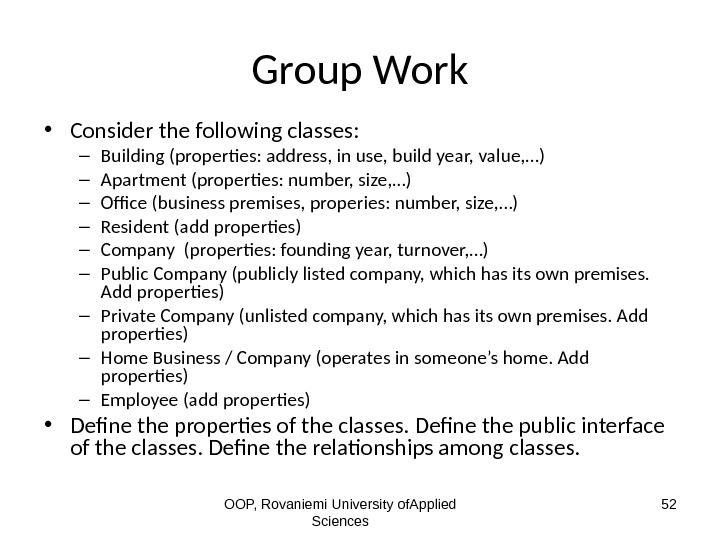


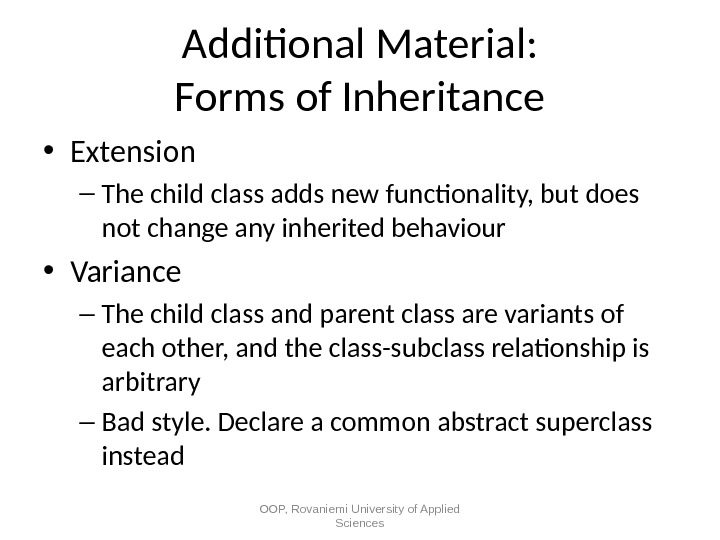
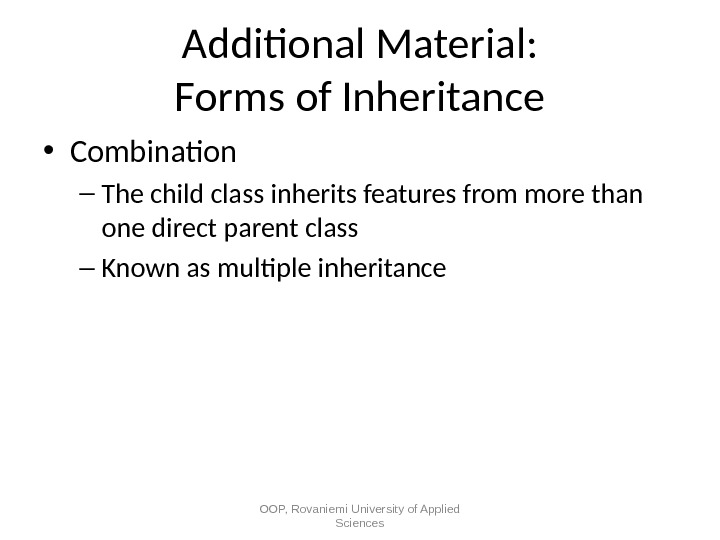
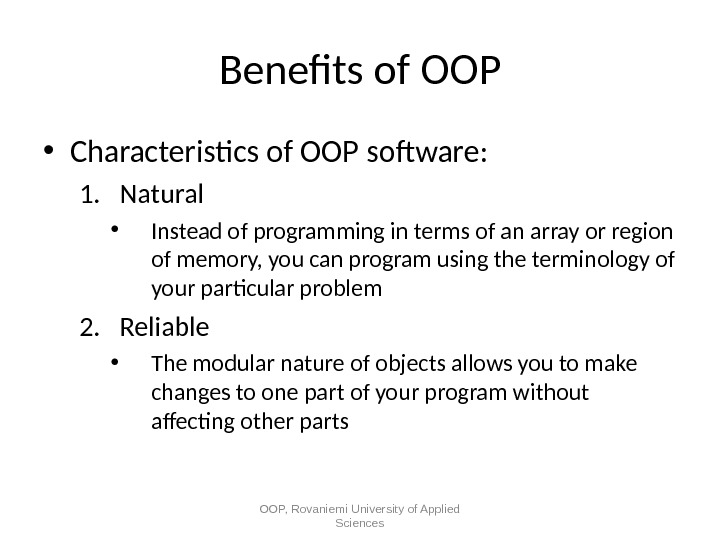
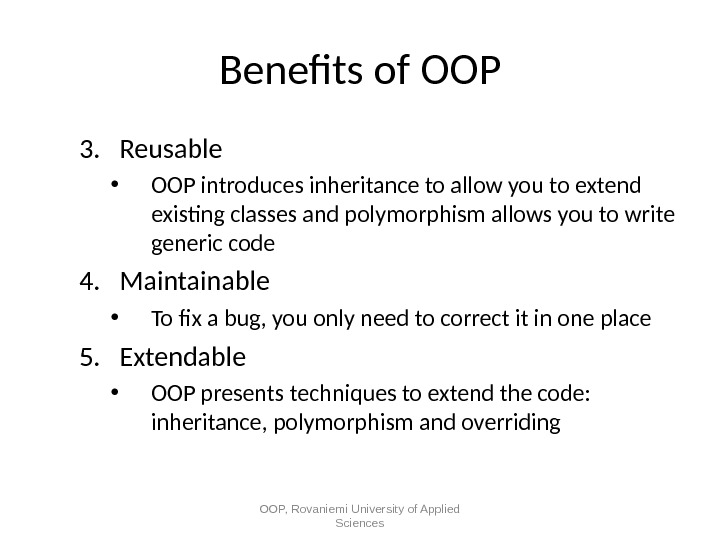
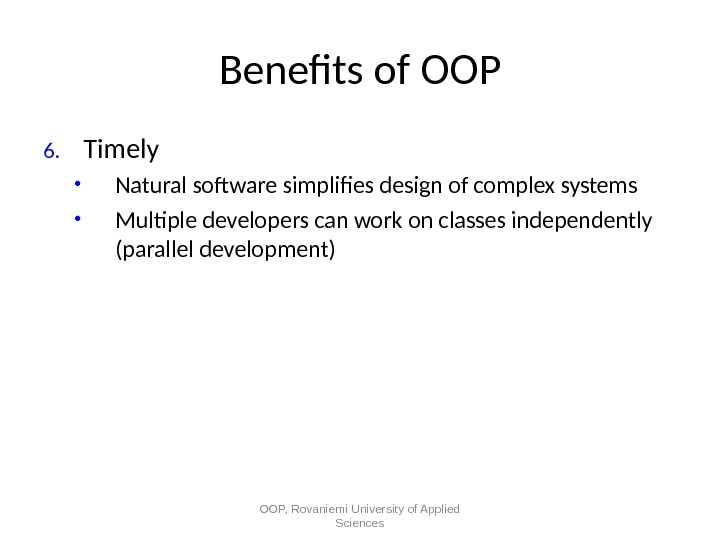
part_i_object-oriented_concepts_and_principles.ppt
- Размер: 706.5 Кб
- Количество слайдов: 59
Описание презентации Object-Oriented Programming and Java Part I: Introduction по слайдам
 Object-Oriented Programming and Java Part I: Introduction to Concepts and Principles of Object-Oriented Programming Course by Mr. Erkki Mattila, M. Sc. Rovaniemi University of Applied Sciences
Object-Oriented Programming and Java Part I: Introduction to Concepts and Principles of Object-Oriented Programming Course by Mr. Erkki Mattila, M. Sc. Rovaniemi University of Applied Sciences
 Object-Oriented Programming and Java Instructor: M. Sc. Erkki Mattila, lecturer Office: C 136 Office hours: according to the weekly schedule published on the net Mobile tel. : 040 740 5862 E-mail: erkki. mattila@ramk. f OOP, Rovaniemi University of Applied Sciences
Object-Oriented Programming and Java Instructor: M. Sc. Erkki Mattila, lecturer Office: C 136 Office hours: according to the weekly schedule published on the net Mobile tel. : 040 740 5862 E-mail: erkki. mattila@ramk. f OOP, Rovaniemi University of Applied Sciences
 Object-Oriented Programming and Java COURSE CODE • 504 D 24 A DURATION • 3 CU (+5 CU = 8 CU) TEACHING • 40 hours of classes, 40 hours of self-supervised work (frst part) OOP, Rovaniemi University of Applied Sciences
Object-Oriented Programming and Java COURSE CODE • 504 D 24 A DURATION • 3 CU (+5 CU = 8 CU) TEACHING • 40 hours of classes, 40 hours of self-supervised work (frst part) OOP, Rovaniemi University of Applied Sciences
 Object-Oriented Programming and Java OBJECTIVES • The main objective of the frst part of the course is to introduce the basic concepts and principles of object-oriented programming • The second part introduces the student to Java programming (Java SE) OOP, Rovaniemi University of Applied Sciences
Object-Oriented Programming and Java OBJECTIVES • The main objective of the frst part of the course is to introduce the basic concepts and principles of object-oriented programming • The second part introduces the student to Java programming (Java SE) OOP, Rovaniemi University of Applied Sciences
 Object-Oriented Programming and Java COURSE MATERIAL • Lecture notes, available at O: \Opettajat\Erkki Mattila\Object-oriented Programming and Java 504 D 24 A — Part 1 • Budd T. 2002. An Introduction to Object-Oriented Programming, 3 rd Edition. Addison-Wesley Longman • Sebesta R. W. 2008. Concepts of Programming Languages, 8 th Edition. Pearson Education. Addison-Wesley OOP, Rovaniemi University of Applied Sciences
Object-Oriented Programming and Java COURSE MATERIAL • Lecture notes, available at O: \Opettajat\Erkki Mattila\Object-oriented Programming and Java 504 D 24 A — Part 1 • Budd T. 2002. An Introduction to Object-Oriented Programming, 3 rd Edition. Addison-Wesley Longman • Sebesta R. W. 2008. Concepts of Programming Languages, 8 th Edition. Pearson Education. Addison-Wesley OOP, Rovaniemi University of Applied Sciences
 Object-Oriented Programming and Java ASSESMENT • Mid-term exam, which will be graded on a scale from 1 to 5 and F. 30 percent of the maximum points are required for grade 1. • The fnal exam will be held after the second 5 CU part of the course. The course grade will be calculated as a weighted average of the mid-term and fnal exam grades OOP, Rovaniemi University of Applied Sciences
Object-Oriented Programming and Java ASSESMENT • Mid-term exam, which will be graded on a scale from 1 to 5 and F. 30 percent of the maximum points are required for grade 1. • The fnal exam will be held after the second 5 CU part of the course. The course grade will be calculated as a weighted average of the mid-term and fnal exam grades OOP, Rovaniemi University of Applied Sciences
 Student level assesment 1. Which programming courses have you participated earlier? 2. How familiar are you with the concepts and principles of object-oriented programming? You may also answer on a scale from 0 to 5, zero being not at all and fve being master level? 3. Do you have prior experience of object-oriented programming languages? If so, which programming languages/tools have you used? 4. Are you familiar with UML (0 -5)? 5. What do you expect/hope to get from this course? OOP, Rovaniemi University of Applied Sciences
Student level assesment 1. Which programming courses have you participated earlier? 2. How familiar are you with the concepts and principles of object-oriented programming? You may also answer on a scale from 0 to 5, zero being not at all and fve being master level? 3. Do you have prior experience of object-oriented programming languages? If so, which programming languages/tools have you used? 4. Are you familiar with UML (0 -5)? 5. What do you expect/hope to get from this course? OOP, Rovaniemi University of Applied Sciences
 Course Contents • Part I: Concepts and Principles of Object-Oriented Programming • Part II: Object-oriented Programming – Closer look at OOP • Part III: Introduction to Java Programming OOP, Rovaniemi University of Applied Sciences
Course Contents • Part I: Concepts and Principles of Object-Oriented Programming • Part II: Object-oriented Programming – Closer look at OOP • Part III: Introduction to Java Programming OOP, Rovaniemi University of Applied Sciences
 Part I Contents 1. Abstraction – The concept of abstraction, data and process abstraction, abstract data types 2. Concepts of Object-Oriented Programming – Class, object, attribute, method, etc. 3. Principles of Object-oriented Programming – Data abstraction (encapsulation and information hiding), inheritance, and polymorphism OOP, Rovaniemi University of Applied Sciences
Part I Contents 1. Abstraction – The concept of abstraction, data and process abstraction, abstract data types 2. Concepts of Object-Oriented Programming – Class, object, attribute, method, etc. 3. Principles of Object-oriented Programming – Data abstraction (encapsulation and information hiding), inheritance, and polymorphism OOP, Rovaniemi University of Applied Sciences
 1. Abstraction
1. Abstraction
 Object-oriented Programming Paradigm • OOP is a common programming paradigm. A programming paradigm is a way to conceptualize how to structure a program to solve a problem – Other programming paradigms include functional programming, logic programming, imperative programming and declarative programming • Common OO programming languages nowadays are Java, C++ ja C# • Common OO modelling languages are UML, OMT ja OMT++. UML is nowadays the de facto standard OOP, Rovaniemi University of Applied Sciences
Object-oriented Programming Paradigm • OOP is a common programming paradigm. A programming paradigm is a way to conceptualize how to structure a program to solve a problem – Other programming paradigms include functional programming, logic programming, imperative programming and declarative programming • Common OO programming languages nowadays are Java, C++ ja C# • Common OO modelling languages are UML, OMT ja OMT++. UML is nowadays the de facto standard OOP, Rovaniemi University of Applied Sciences
 C Data Types Revisited • Which built-in, primitive data types the C programming language has? • What are structure types (struct) in C language? • What is the relationship between functions and data in C language? OOP, Rovaniemi University of Applied Sciences
C Data Types Revisited • Which built-in, primitive data types the C programming language has? • What are structure types (struct) in C language? • What is the relationship between functions and data in C language? OOP, Rovaniemi University of Applied Sciences
 Defnition: Abstract Data Type • An abstract data type is a data type that satisfes the following conditions: – The declarations of the type and (the protocols of) the operations of the type are contained in a single syntactic unit (encapsulation) – Other program units are allowed to create variables of the type – The representation of objects of the type is hidden from other program units. The only direct operations possible on those objects are those provided in the type’s defnition (information hiding) Sebesta R. W. 2008. Concepts of Programming Languages , 8 th Edtion. Addison Wesley OOP, Rovaniemi University of Applied Sciences
Defnition: Abstract Data Type • An abstract data type is a data type that satisfes the following conditions: – The declarations of the type and (the protocols of) the operations of the type are contained in a single syntactic unit (encapsulation) – Other program units are allowed to create variables of the type – The representation of objects of the type is hidden from other program units. The only direct operations possible on those objects are those provided in the type’s defnition (information hiding) Sebesta R. W. 2008. Concepts of Programming Languages , 8 th Edtion. Addison Wesley OOP, Rovaniemi University of Applied Sciences
 Abstract Data Types (ADT) • ADTs are defned by the user (user-defned type) • ADTs should provide the same characteristics provided by language-defned types, such as an integer or a floating point type: – A type’s defnition that allows program units to declare variables of the type, but hides the representation of the objects of the type – A set of operations for manipulating objects of the type • In OOP abstract data types are implemented as classes • An instance of an abstract data type is called an object OOP, Rovaniemi University of Applied Sciences
Abstract Data Types (ADT) • ADTs are defned by the user (user-defned type) • ADTs should provide the same characteristics provided by language-defned types, such as an integer or a floating point type: – A type’s defnition that allows program units to declare variables of the type, but hides the representation of the objects of the type – A set of operations for manipulating objects of the type • In OOP abstract data types are implemented as classes • An instance of an abstract data type is called an object OOP, Rovaniemi University of Applied Sciences
 Scope • A class consists of data felds (attributes) and operations, which manipulate the data • The data felds/ attributes can be accessed anywhere inside the class itself ; i. e. all operations of the class have direct access to class’s data OOP, Rovaniemi University of Applied Sciences
Scope • A class consists of data felds (attributes) and operations, which manipulate the data • The data felds/ attributes can be accessed anywhere inside the class itself ; i. e. all operations of the class have direct access to class’s data OOP, Rovaniemi University of Applied Sciences
 Group Work • Defne a new abstract data type – Name of the type – Attributes (Data felds) – Operations OOP, Rovaniemi University of Applied Sciences
Group Work • Defne a new abstract data type – Name of the type – Attributes (Data felds) – Operations OOP, Rovaniemi University of Applied Sciences
 Relation of Abstract Data Types to Object-oriented Programming • Object-oriented programming (OOP) is an outgrowth of the use of ADTs • Data abstraction is one the most important components of OOP • In OOP languages abstract data types are implemented as classes ! • An instance of a class is called an object! OOP, Rovaniemi University of Applied Sciences
Relation of Abstract Data Types to Object-oriented Programming • Object-oriented programming (OOP) is an outgrowth of the use of ADTs • Data abstraction is one the most important components of OOP • In OOP languages abstract data types are implemented as classes ! • An instance of a class is called an object! OOP, Rovaniemi University of Applied Sciences
 2. Concepts of Object-oriented Programming
2. Concepts of Object-oriented Programming
 Classes are reusable software components that model items in the real world A class encapsulates the data and procedural abstractions (operations) that are required to describe the content and behaviour of some real world entity A program written in pure OOP language consists of classes – there can be no code outside of classes A class is a compile-time concept OOP, Rovaniemi University of Applied Sciences attributes: class name methods:
Classes are reusable software components that model items in the real world A class encapsulates the data and procedural abstractions (operations) that are required to describe the content and behaviour of some real world entity A program written in pure OOP language consists of classes – there can be no code outside of classes A class is a compile-time concept OOP, Rovaniemi University of Applied Sciences attributes: class name methods:
 Object • An object is an instance of a class • Objects are created during program execution – object is a run-time concept • Multiple objects can be instantiated of the same class • Each object has its own values for the instance variables (attributes) of its class – These values defne the state of the object OOP, Rovaniemi University of Applied Sciences
Object • An object is an instance of a class • Objects are created during program execution – object is a run-time concept • Multiple objects can be instantiated of the same class • Each object has its own values for the instance variables (attributes) of its class – These values defne the state of the object OOP, Rovaniemi University of Applied Sciences
 Classes and Objects OOP, Rovaniemi University of Applied Sciences An object is an instance of a class. It gives specific values to the fields of the classcost dimensions weight location colourclass: furniture buy sell weigh move Cost = 100 Dimensions = dim Weight = 50 Location = loc Colour = blueobject: chair buy sell weigh move
Classes and Objects OOP, Rovaniemi University of Applied Sciences An object is an instance of a class. It gives specific values to the fields of the classcost dimensions weight location colourclass: furniture buy sell weigh move Cost = 100 Dimensions = dim Weight = 50 Location = loc Colour = blueobject: chair buy sell weigh move
 Attributes • People have features including date of birth, name, height and eye colour • Physical objects have features such as shape, weight, colour, etc • Similar l y classes have attributes (=felds, member variables) • The values assigned to an object’s attributes make that object unique; they defne the state of an object OOP, Rovaniemi University of Applied Sciences
Attributes • People have features including date of birth, name, height and eye colour • Physical objects have features such as shape, weight, colour, etc • Similar l y classes have attributes (=felds, member variables) • The values assigned to an object’s attributes make that object unique; they defne the state of an object OOP, Rovaniemi University of Applied Sciences
 Methods • A class encapsulates data and the algorithms that process that data. These algorithms are called methods , operations, functions, routines or services • Each of the methods provide a representation of one of the behaviours of the object – Behaviour = method implementation • Whenever an object receives a message , it initiates some behaviour by executing a method – Message = method call OOP, Rovaniemi University of Applied Sciences
Methods • A class encapsulates data and the algorithms that process that data. These algorithms are called methods , operations, functions, routines or services • Each of the methods provide a representation of one of the behaviours of the object – Behaviour = method implementation • Whenever an object receives a message , it initiates some behaviour by executing a method – Message = method call OOP, Rovaniemi University of Applied Sciences
 Messages (Method Calls) • Messages are the means by which objects interact. A message stimulates some behaviour to occur in the receiving object. The behaviour is accomplished when a method is called and executed OOP, Rovaniemi University of Applied Sciences. Sender object Receiver objectsender. method(parameters) receiver. method(parameters) Pressman R. , p.
Messages (Method Calls) • Messages are the means by which objects interact. A message stimulates some behaviour to occur in the receiving object. The behaviour is accomplished when a method is called and executed OOP, Rovaniemi University of Applied Sciences. Sender object Receiver objectsender. method(parameters) receiver. method(parameters) Pressman R. , p.
 Constructor • A specialized method used to instantiate an object • The constructor function has the same name as the class • It is never called directly, but the run-time system calls it when a new object is created • Constructors are usually overloaded; a class contains multiple constructors, which have a different set of parameters OOP, Rovaniemi University of Applied Sciences
Constructor • A specialized method used to instantiate an object • The constructor function has the same name as the class • It is never called directly, but the run-time system calls it when a new object is created • Constructors are usually overloaded; a class contains multiple constructors, which have a different set of parameters OOP, Rovaniemi University of Applied Sciences
 A Class Defnition in Java Language publicclass. Shape { privatestaticinta_number. Of. Shapes=0; private. Colora_color; public. Shape() { Shape. a_number. Of. Shapes++; a_color=Color. BLACK; } public. Shape(Colorc) { Shape. a_number. Of. Shapes++; a_color=c; } OOP, Rovaniemi University of Applied Sciences
A Class Defnition in Java Language publicclass. Shape { privatestaticinta_number. Of. Shapes=0; private. Colora_color; public. Shape() { Shape. a_number. Of. Shapes++; a_color=Color. BLACK; } public. Shape(Colorc) { Shape. a_number. Of. Shapes++; a_color=c; } OOP, Rovaniemi University of Applied Sciences
 A Class Defnition in Java Language public class Circle extends Shape // Class header { private int radius ; // Member variable public Circle() // Constructor { radius = 0; } public Circle(int r, Color c) { super( c ); // Calling superclass contructor radius = r; } public long calculate. Area() // Member function { return Math. round(Math. PI*radius); } } OOP, Rovaniemi University of Applied Sciences
A Class Defnition in Java Language public class Circle extends Shape // Class header { private int radius ; // Member variable public Circle() // Constructor { radius = 0; } public Circle(int r, Color c) { super( c ); // Calling superclass contructor radius = r; } public long calculate. Area() // Member function { return Math. round(Math. PI*radius); } } OOP, Rovaniemi University of Applied Sciences
 Group Work • Your task is to design an ATM (Automatic Bank Teller Machine) system – Which classes (and objects) should the system contain? – Which attributes and operations the classes should have? OOP, Rovaniemi University of Applied Sciences
Group Work • Your task is to design an ATM (Automatic Bank Teller Machine) system – Which classes (and objects) should the system contain? – Which attributes and operations the classes should have? OOP, Rovaniemi University of Applied Sciences
 OOP — Rovaniemi University of Applied Sciences. Class Relationships 1) Generalization (Inheritance) 2) Aggregation Special case: composition 3) Association • Dependency and Realization relationships will be coverered in the Design Methods course
OOP — Rovaniemi University of Applied Sciences. Class Relationships 1) Generalization (Inheritance) 2) Aggregation Special case: composition 3) Association • Dependency and Realization relationships will be coverered in the Design Methods course
 OOP — Rovaniemi University of Applied Sciences. Inheritance (“is a”) Relationship • Classes may be arranged in a class hierarchy where one class (a superclass) is a generalisation of one or more other classes (subclasses) • Generalization: creating a common supertype for a group of classes – Dog, Cat, Horse => supertype Animal • Specialization: creating extended versions of existing classes or objects. This is also called subtyping. Subclass is a special case of the superclass – Animal => subtypes Dog, Cat, Horse • A subclass inherits the attributes and operations from its superclass and may add new methods or attributes of its own – For instance Animal class contains the features common to all animals
OOP — Rovaniemi University of Applied Sciences. Inheritance (“is a”) Relationship • Classes may be arranged in a class hierarchy where one class (a superclass) is a generalisation of one or more other classes (subclasses) • Generalization: creating a common supertype for a group of classes – Dog, Cat, Horse => supertype Animal • Specialization: creating extended versions of existing classes or objects. This is also called subtyping. Subclass is a special case of the superclass – Animal => subtypes Dog, Cat, Horse • A subclass inherits the attributes and operations from its superclass and may add new methods or attributes of its own – For instance Animal class contains the features common to all animals
 OOP — Rovaniemi University of Applied Sciences. Generalization (Inheritance) Employee Programmer project prog. Language s. Manager budgets. Controlle d date. Appointed Project Man-r projects Dept. Man-r department Area Man-r responsibilities
OOP — Rovaniemi University of Applied Sciences. Generalization (Inheritance) Employee Programmer project prog. Language s. Manager budgets. Controlle d date. Appointed Project Man-r projects Dept. Man-r department Area Man-r responsibilities
 Group work • Defne a rectangle and a square as classes. • Can they be modelled with a single class? • If they are modelled as separate classes, is one a superclass of the other? Why? • Start by defning the Rectangle class. Declare attributes and constructor methods. Initilize attributes in contructors. – Remember that constructors can be overloaded – Remember that superclass constructor method can be called in the subclass using the keyword super • Add a method for calculating the area of the rectangle OOP, Rovaniemi University of Applied Sciences
Group work • Defne a rectangle and a square as classes. • Can they be modelled with a single class? • If they are modelled as separate classes, is one a superclass of the other? Why? • Start by defning the Rectangle class. Declare attributes and constructor methods. Initilize attributes in contructors. – Remember that constructors can be overloaded – Remember that superclass constructor method can be called in the subclass using the keyword super • Add a method for calculating the area of the rectangle OOP, Rovaniemi University of Applied Sciences
 OOP — Rovaniemi University of Applied Sciences. Aggregation (“part of“) Relationship • Shows how classes that are collections are composed of other classes. • Models the notion that one object uses another object without «owning» it and thus is not responsible for its creation or destruction. • Similar to the part-of relationship in semantic data models. Assignment Credits Exercises #Problems Description Solutions Text Diagrams
OOP — Rovaniemi University of Applied Sciences. Aggregation (“part of“) Relationship • Shows how classes that are collections are composed of other classes. • Models the notion that one object uses another object without «owning» it and thus is not responsible for its creation or destruction. • Similar to the part-of relationship in semantic data models. Assignment Credits Exercises #Problems Description Solutions Text Diagrams
 OOP — Rovaniemi University of Applied Sciences. Composition (“has a “) Relationship • Composition is a special form of aggregation describing the situation where an object contains a number of other objects and when the containing object is deleted, all the instances of the objects that are contained disappear • The contained (member) object cannot exist without its owning object and can belong to one owner only at any given time Government Minister
OOP — Rovaniemi University of Applied Sciences. Composition (“has a “) Relationship • Composition is a special form of aggregation describing the situation where an object contains a number of other objects and when the containing object is deleted, all the instances of the objects that are contained disappear • The contained (member) object cannot exist without its owning object and can belong to one owner only at any given time Government Minister
 OOP — Rovaniemi University of Applied Sciences. Composition vs. Aggregation • Composition is a stricter relationship than aggregation: 1. Member objects cannot exist without the containing object. 2. A member object can belong to only one containing object at a time. • Example of composition: a minister cannot exist without a government, and a minister can be a part of only one government at a time.
OOP — Rovaniemi University of Applied Sciences. Composition vs. Aggregation • Composition is a stricter relationship than aggregation: 1. Member objects cannot exist without the containing object. 2. A member object can belong to only one containing object at a time. • Example of composition: a minister cannot exist without a government, and a minister can be a part of only one government at a time.
 OOP — Rovaniemi University of Applied Sciences. Association (“uses”) Relationship • One entity uses another entity as part of its behavior • Used when the relationship is permanent • In the code level one class has a member variable of another class type Manager Employee 1 1. . *
OOP — Rovaniemi University of Applied Sciences. Association (“uses”) Relationship • One entity uses another entity as part of its behavior • Used when the relationship is permanent • In the code level one class has a member variable of another class type Manager Employee 1 1. . *
 OOP — Rovaniemi University of Applied Sciences. Attributes and Associations • Attributes and associations are exchangeable! – When the relationship exists between classes in your own class model, use an association in the UML class diagram – When the relationship exists between a class in your own class model and a class from a class library, use an attiribute Book -author: Author is the same as: Book Author author
OOP — Rovaniemi University of Applied Sciences. Attributes and Associations • Attributes and associations are exchangeable! – When the relationship exists between classes in your own class model, use an association in the UML class diagram – When the relationship exists between a class in your own class model and a class from a class library, use an attiribute Book -author: Author is the same as: Book Author author
 Group Work • Draw an UML class diagram containing the following classes: Car, Bicycle, Motorcycle, Steamship, Sailboat, Sail, Train, Wheel (tyre), Engine, Motorship, Watercraft, Vehicle (means of transportation), Landvehicle, Road, Railway, Waterway, Seat (bench). • Put classes to a class diagram and add some attributes to them. Do the classes have some common attributes? • Add appropriate relationships between the classes – Start by defning the class hierarchy – Add common features as high as possible in the inheritance hierarchy OOP, Rovaniemi University of Applied Sciences
Group Work • Draw an UML class diagram containing the following classes: Car, Bicycle, Motorcycle, Steamship, Sailboat, Sail, Train, Wheel (tyre), Engine, Motorship, Watercraft, Vehicle (means of transportation), Landvehicle, Road, Railway, Waterway, Seat (bench). • Put classes to a class diagram and add some attributes to them. Do the classes have some common attributes? • Add appropriate relationships between the classes – Start by defning the class hierarchy – Add common features as high as possible in the inheritance hierarchy OOP, Rovaniemi University of Applied Sciences
 3. Principles of Object-oriented Programming
3. Principles of Object-oriented Programming
 Encapsulation • A class encapsulates together data (attributes), methods, constants, and other related information • Encapsulation means that all of this information is packaged under one name and can be reused as one specification or program component OOP, Rovaniemi University of Applied Sciences
Encapsulation • A class encapsulates together data (attributes), methods, constants, and other related information • Encapsulation means that all of this information is packaged under one name and can be reused as one specification or program component OOP, Rovaniemi University of Applied Sciences
 Encapsulation: Example OOP, Rovaniemi University of Applied Sciences G. Booch, “Object-oriented analysis and design with applications”
Encapsulation: Example OOP, Rovaniemi University of Applied Sciences G. Booch, “Object-oriented analysis and design with applications”
 Benefts of Encapsulation • Data structures and the methods that manipulate them are merged in a single named entity – the class – Facilitates component reuse • Interfaces among encapsulated objects are simplifed. An object that sends a message need not be concerned with the details of internal data structures – Greatly reduces programmer’s memory load OOP, Rovaniemi University of Applied Sciences
Benefts of Encapsulation • Data structures and the methods that manipulate them are merged in a single named entity – the class – Facilitates component reuse • Interfaces among encapsulated objects are simplifed. An object that sends a message need not be concerned with the details of internal data structures – Greatly reduces programmer’s memory load OOP, Rovaniemi University of Applied Sciences
 Data Abstraction and Information Hiding • DA isolates how a compound data object is used from the details of how it is constructed from more primitive data objects – Consider a class Stack and its operations push and pop • The client cares about what services a class offers, not about class’s internal data structures or how the services are implemented OOP, Rovaniemi University of Applied Sciences
Data Abstraction and Information Hiding • DA isolates how a compound data object is used from the details of how it is constructed from more primitive data objects – Consider a class Stack and its operations push and pop • The client cares about what services a class offers, not about class’s internal data structures or how the services are implemented OOP, Rovaniemi University of Applied Sciences
 Data Abstraction and Information Hiding • Classes normally hide the details of their implementation from their clients. This is called information hiding • Although programmers might know the details of a class’s implementation, they should not write code that depends on these details as the details may later change OOP, Rovaniemi University of Applied Sciences
Data Abstraction and Information Hiding • Classes normally hide the details of their implementation from their clients. This is called information hiding • Although programmers might know the details of a class’s implementation, they should not write code that depends on these details as the details may later change OOP, Rovaniemi University of Applied Sciences
 Data Abstraction and Information Hiding • From the defnition of an abstract data type: – The declarations of the type and the protocols of the operations on objects of the type, which provide type’s interface , are contained in a single syntactic unit • Data Abstraction (type’s interface) and Encapsulation (single syntactic unit) – The representation of objects of the type is hidden from other program units. The only direct operations possible on those objects are those provided in the type’s defnition • Information hiding OOP, Rovaniemi University of Applied Sciences
Data Abstraction and Information Hiding • From the defnition of an abstract data type: – The declarations of the type and the protocols of the operations on objects of the type, which provide type’s interface , are contained in a single syntactic unit • Data Abstraction (type’s interface) and Encapsulation (single syntactic unit) – The representation of objects of the type is hidden from other program units. The only direct operations possible on those objects are those provided in the type’s defnition • Information hiding OOP, Rovaniemi University of Applied Sciences
 Information Hiding • A type’s internal form is hidden behind a set of access functions • Values of the type are created, inspected and modifed only by calls to the access functions • This allows the implementation of the type to be changed without requiring any changes outside the module in which it is defned OOP, Rovaniemi University of Applied Sciences
Information Hiding • A type’s internal form is hidden behind a set of access functions • Values of the type are created, inspected and modifed only by calls to the access functions • This allows the implementation of the type to be changed without requiring any changes outside the module in which it is defned OOP, Rovaniemi University of Applied Sciences
 Benefts of Information Hiding • The internal implementation details of data and procedures are hidden from the outside world. This reduces the propagation of side effects when changes occur • Preserving the integrity of objects – Illegal attribute values not allowed • More on information hiding and using access specifers to implement it in the second slide set OOP, Rovaniemi University of Applied Sciences
Benefts of Information Hiding • The internal implementation details of data and procedures are hidden from the outside world. This reduces the propagation of side effects when changes occur • Preserving the integrity of objects – Illegal attribute values not allowed • More on information hiding and using access specifers to implement it in the second slide set OOP, Rovaniemi University of Applied Sciences
 Inheritance • Inheritance is a mechanism that enables the responsibilities of one object to be propagated to other objects • In a class hierarchy the attributes and methods of the superclass are inherited by subclasses that may each additional “private” attributes and methods • Inheritance can also be called as – Specialization : creating extended versions of existing classes or objects. This is also called subtyping. Subclass is a special case of the superclass – Generalization : creating a common supertype for a group of classes OOP, Rovaniemi University of Applied Sciences
Inheritance • Inheritance is a mechanism that enables the responsibilities of one object to be propagated to other objects • In a class hierarchy the attributes and methods of the superclass are inherited by subclasses that may each additional “private” attributes and methods • Inheritance can also be called as – Specialization : creating extended versions of existing classes or objects. This is also called subtyping. Subclass is a special case of the superclass – Generalization : creating a common supertype for a group of classes OOP, Rovaniemi University of Applied Sciences
 Class Hierarchy OOP, Rovaniemi University of Applied Sciencesclass: Furniture class: Chair class: Table class: Desk class: Arm. Chair class: Rocking. Chair
Class Hierarchy OOP, Rovaniemi University of Applied Sciencesclass: Furniture class: Chair class: Table class: Desk class: Arm. Chair class: Rocking. Chair
 Class Hierarchy • Direct superclass – Inherited explicitly (one level up hierarchy) • Indirect superclass – Inherited two or more levels up hierarchy • Single inheritance – Inherits from one direct superclass • Multiple inheritance – Inherits from multiple direct superclasses • C++ supports multiple inheritance, Java does not OOP, Rovaniemi University of Applied Sciences
Class Hierarchy • Direct superclass – Inherited explicitly (one level up hierarchy) • Indirect superclass – Inherited two or more levels up hierarchy • Single inheritance – Inherits from one direct superclass • Multiple inheritance – Inherits from multiple direct superclasses • C++ supports multiple inheritance, Java does not OOP, Rovaniemi University of Applied Sciences
 Benefts of Inheritance • Inheritance occurs throughout all levels of a class hierarchy. Changes at the higher level are immediately propagated through a system • Reuse of components is accomplished directly OOP, Rovaniemi University of Applied Sciences
Benefts of Inheritance • Inheritance occurs throughout all levels of a class hierarchy. Changes at the higher level are immediately propagated through a system • Reuse of components is accomplished directly OOP, Rovaniemi University of Applied Sciences
 OOP, Rovaniemi University of. Applied Sciences 52 Group Work • Consider the following classes: – Building (properties: address, in use, build year, value, …) – Apartment (properties: number, size, …) – Office (business premises, properies: number, size, …) – Resident (add properties) – Company (properties: founding year, turnover, …) – Public Company (publicly listed company, which has its own premises. Add properties) – Private Company (unlisted company, which has its own premises. Add properties) – Home Business / Company (operates in someone’s home. Add properties) – Employee (add properties) • Defne the properties of the classes. Defne the public interface of the classes. Defne the relationships among classes.
OOP, Rovaniemi University of. Applied Sciences 52 Group Work • Consider the following classes: – Building (properties: address, in use, build year, value, …) – Apartment (properties: number, size, …) – Office (business premises, properies: number, size, …) – Resident (add properties) – Company (properties: founding year, turnover, …) – Public Company (publicly listed company, which has its own premises. Add properties) – Private Company (unlisted company, which has its own premises. Add properties) – Home Business / Company (operates in someone’s home. Add properties) – Employee (add properties) • Defne the properties of the classes. Defne the public interface of the classes. Defne the relationships among classes.
 Additional Material: Forms of Inheritance • Specialization – The child class is a special case of the parent class • Specifcation – The parent class defnes behaviour that is implemented in the child class, but not in the parent class – Used to guarantee that classes maintain a certain common interface – that is, they implement the same methods OOP, Rovaniemi University of Applied Sciences
Additional Material: Forms of Inheritance • Specialization – The child class is a special case of the parent class • Specifcation – The parent class defnes behaviour that is implemented in the child class, but not in the parent class – Used to guarantee that classes maintain a certain common interface – that is, they implement the same methods OOP, Rovaniemi University of Applied Sciences
 Additional Material: Forms of Inheritance • Construction – The child class makes use of the behaviour provided by the parent class, but is not a subtype of the parent class • Generalization – The child class modifes or overrides some of the methods of the parent class to create a more general kind of object – Bad style. Use only if you cannot modify the parent class OOP, Rovaniemi University of Applied Sciences
Additional Material: Forms of Inheritance • Construction – The child class makes use of the behaviour provided by the parent class, but is not a subtype of the parent class • Generalization – The child class modifes or overrides some of the methods of the parent class to create a more general kind of object – Bad style. Use only if you cannot modify the parent class OOP, Rovaniemi University of Applied Sciences
 Additional Material: Forms of Inheritance • Extension – The child class adds new functionality, but does not change any inherited behaviour • Variance – The child class and parent class are variants of each other, and the class-subclass relationship is arbitrary – Bad style. Declare a common abstract superclass instead OOP, Rovaniemi University of Applied Sciences
Additional Material: Forms of Inheritance • Extension – The child class adds new functionality, but does not change any inherited behaviour • Variance – The child class and parent class are variants of each other, and the class-subclass relationship is arbitrary – Bad style. Declare a common abstract superclass instead OOP, Rovaniemi University of Applied Sciences
 Additional Material: Forms of Inheritance • Combination – The child class inherits features from more than one direct parent class – Known as multiple inheritance OOP, Rovaniemi University of Applied Sciences
Additional Material: Forms of Inheritance • Combination – The child class inherits features from more than one direct parent class – Known as multiple inheritance OOP, Rovaniemi University of Applied Sciences
 Benefts of OOP • Characteristics of OOP software: 1. Natural • Instead of programming in terms of an array or region of memory, you can program using the terminology of your particular problem 2. Reliable • The modular nature of objects allows you to make changes to one part of your program without affecting other parts OOP, Rovaniemi University of Applied Sciences
Benefts of OOP • Characteristics of OOP software: 1. Natural • Instead of programming in terms of an array or region of memory, you can program using the terminology of your particular problem 2. Reliable • The modular nature of objects allows you to make changes to one part of your program without affecting other parts OOP, Rovaniemi University of Applied Sciences
 Benefts of OOP 3. Reusable • OOP introduces inheritance to allow you to extend existing classes and polymorphism allows you to write generic code 4. Maintainable • To fx a bug, you only need to correct it in one place 5. Extendable • OOP presents techniques to extend the code: inheritance, polymorphism and overriding OOP, Rovaniemi University of Applied Sciences
Benefts of OOP 3. Reusable • OOP introduces inheritance to allow you to extend existing classes and polymorphism allows you to write generic code 4. Maintainable • To fx a bug, you only need to correct it in one place 5. Extendable • OOP presents techniques to extend the code: inheritance, polymorphism and overriding OOP, Rovaniemi University of Applied Sciences
 Benefts of OOP 6. Timely • Natural software simplifes design of complex systems • Multiple developers can work on classes independently (parallel development) OOP, Rovaniemi University of Applied Sciences
Benefts of OOP 6. Timely • Natural software simplifes design of complex systems • Multiple developers can work on classes independently (parallel development) OOP, Rovaniemi University of Applied Sciences
